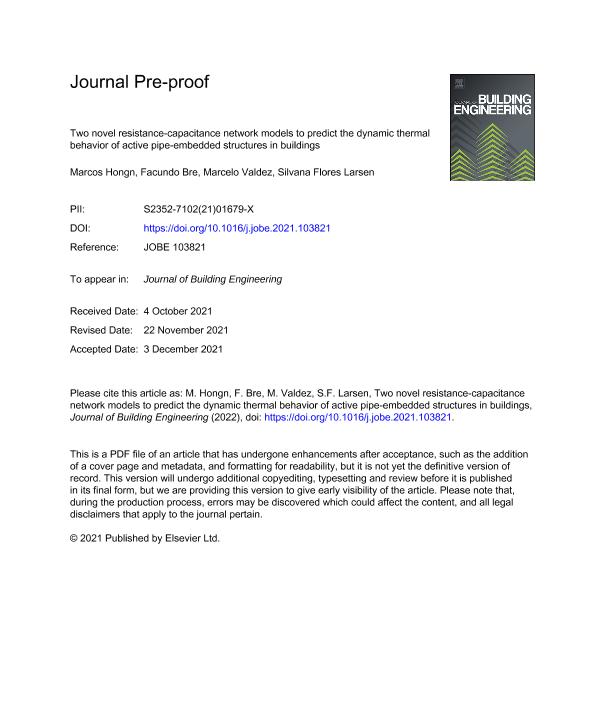Mostrar el registro sencillo del ítem
dc.contributor.author
Hongn, Marcos Ezequiel

dc.contributor.author
Bre, Facundo

dc.contributor.author
Valdez, Marcelo Federico

dc.contributor.author
Flores Larsen, Silvana Elinor

dc.date.available
2023-07-28T12:47:15Z
dc.date.issued
2022-04-15
dc.identifier.citation
Hongn, Marcos Ezequiel; Bre, Facundo; Valdez, Marcelo Federico; Flores Larsen, Silvana Elinor; Two novel resistance-capacitance network models to predict the dynamic thermal behavior of active pipe-embedded structures in buildings; Elsevier; Journal of Building Engineering; 47; 15-4-2022; 1-22
dc.identifier.issn
2352-7102
dc.identifier.uri
http://hdl.handle.net/11336/205915
dc.description.abstract
Active pipe-embedded structures (APES) are promising low-energy systems for reducing cooling and heating loads in buildings. These structures are usually multilayered, having a main concrete layer where pipes are located. Simplified heat transfer models of these systems are often required for building energy performance simulations. The majority of the simplified models available in the literature show limitations to capture accurately the dynamic thermal behavior of these systems, especially when they have large thermal mass. The goal of the present effort is to introduce two new Resistance-Capacitance (RC) network models, the Delta and the Umbrella, for the main concrete layer of a prototypical APES system. The parameters of the models are obtained through a genetic algorithm, which is dynamically coupled with the models. This algorithm minimizes the error between the RC networks and a baseline dataset that was generated through a frequency-domain finite-difference (FDFD) model of an APES system. To assess the performance of the proposed models, they are compared with two others from the literature for three different thicknesses of the main layer. The results show that the Delta RC network has, in general, similar performance to the literature models. The overall nRMSE (normalized root mean square error) values for these models is between 6% and 10%. They are able to predict accurately the thermal response of the system to some of the boundary conditions analyzed, but show limitations for massive concrete layers under high frequency thermal fluctuations. The Umbrella RC network, on the other hand, was shown to have remarkable accuracy at higher frequencies than the other models, even for the massive structures. The overall nRMSE value for this model was of 3%.
dc.format
application/pdf
dc.language.iso
eng
dc.publisher
Elsevier

dc.rights
info:eu-repo/semantics/openAccess
dc.rights.uri
https://creativecommons.org/licenses/by-nc-sa/2.5/ar/
dc.subject
ACTIVE PIPE-EMBEDDED STRUCTURE
dc.subject
CALIBRATION
dc.subject
GENETIC ALGORITHM
dc.subject
RC NETWORK
dc.subject
SIMPLIFIED THERMAL MODEL
dc.subject
THERMAL FREQUENCY RESPONSE
dc.subject.classification
Ingeniería Civil

dc.subject.classification
Ingeniería Civil

dc.subject.classification
INGENIERÍAS Y TECNOLOGÍAS

dc.subject.classification
Mecánica Aplicada

dc.subject.classification
Ingeniería Mecánica

dc.subject.classification
INGENIERÍAS Y TECNOLOGÍAS

dc.title
Two novel resistance-capacitance network models to predict the dynamic thermal behavior of active pipe-embedded structures in buildings
dc.type
info:eu-repo/semantics/article
dc.type
info:ar-repo/semantics/artículo
dc.type
info:eu-repo/semantics/publishedVersion
dc.date.updated
2023-07-05T13:32:08Z
dc.journal.volume
47
dc.journal.pagination
1-22
dc.journal.pais
Países Bajos

dc.description.fil
Fil: Hongn, Marcos Ezequiel. Consejo Nacional de Investigaciones Científicas y Técnicas. Centro Científico Tecnológico Conicet - Salta. Instituto de Investigaciones en Energía no Convencional. Universidad Nacional de Salta. Facultad de Ciencias Exactas. Departamento de Física. Instituto de Investigaciones en Energía no Convencional; Argentina
dc.description.fil
Fil: Bre, Facundo. Consejo Nacional de Investigaciones Científicas y Técnicas. Centro Científico Tecnológico Conicet - Santa Fe. Centro de Investigaciones en Métodos Computacionales. Universidad Nacional del Litoral. Centro de Investigaciones en Métodos Computacionales; Argentina
dc.description.fil
Fil: Valdez, Marcelo Federico. Consejo Nacional de Investigaciones Científicas y Técnicas. Centro Científico Tecnológico Conicet - Salta. Instituto de Investigaciones en Energía no Convencional. Universidad Nacional de Salta. Facultad de Ciencias Exactas. Departamento de Física. Instituto de Investigaciones en Energía no Convencional; Argentina
dc.description.fil
Fil: Flores Larsen, Silvana Elinor. Consejo Nacional de Investigaciones Científicas y Técnicas. Centro Científico Tecnológico Conicet - Salta. Instituto de Investigaciones en Energía no Convencional. Universidad Nacional de Salta. Facultad de Ciencias Exactas. Departamento de Física. Instituto de Investigaciones en Energía no Convencional; Argentina
dc.journal.title
Journal of Building Engineering
dc.relation.alternativeid
info:eu-repo/semantics/altIdentifier/url/https://www.sciencedirect.com/science/article/pii/S235271022101679X?via%3Dihub
dc.relation.alternativeid
info:eu-repo/semantics/altIdentifier/doi/http://dx.doi.org/10.1016/j.jobe.2021.103821
Archivos asociados
